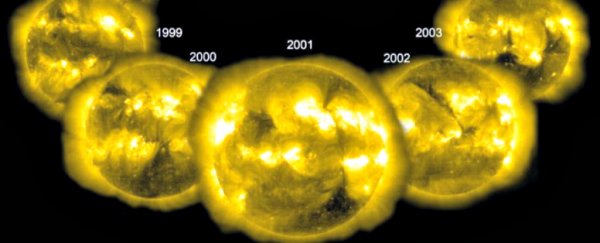Our Sun is a beautiful, bubbling mess of plasma that's controlled by its magnetic field - and roughly once every 11 years, the polarity of that magnetic field is reversed, causing a spike in Sun spots and solar flares.
It's beautiful and predictable, but also baffling. What controls the magnetic field? And what causes those regular fluctuations? It's something that's puzzled scientists for decades, but a group of researchers have just put forward a possible new explanation: maybe it's us.
Well, not just us, but Earth, Venus, and Jupiter combined. The researchers came up with the idea because not only does the Sun's magnetic field flip every 11 years, every 11.07 years, the Sun, Earth, Venus, and Jupiter are all aligned.
"We asked ourselves: is it a coincidence that the solar cycle corresponds with the cycle of the conjunction or the opposition of the three planets?" said one of the physicists, Frank Stefani, from Helmholtz-Zentrum Dresden-Rossendorf in Germany.
That question isn't new, and researchers have noticed the link between the planetary alignment and the Sun's magnetic field before, but they haven't been able to figure out how the very weak tidal effects of three planets could influence the Sun's dynamo.
But with new calculations into the behaviour of the solar magnetic field, the team has found evidence to suggest that, thanks to the principle of resonance - the build up of an effect - the planets could actually be having a profound effect on the Sun.
Here's what we know so far.
The Sun's dynamo magnetic field is controlled by a combination of two effects: the omega effect and the alpha effect. The omega effect is understood to originate in the tachocline - the narrow band between the Sun's inner radiative zone and the outer areas.
In the tachocline, lots of different rotating areas converge, and researchers suspect that this generates two magnetic belts situated north and south of the solar equator.
But the alpha effect is more mysterious. The alpha effect is what creates the poloidal field - one that circles from pole to pole - and a leading hypothesis suggests that it originates near sunspots on the Sun's surface. But this has never quite explained the 11-year cycle.
The German team has an alternate hypothesis - their calculations show that the alpha effect is prone to oscillations under certain conditions, and these oscillations could be triggered by the alignment of the three planets, before growing into something more powerful.
"The impulse for this alpha-oscillation requires almost no energy," said Stefani. "The planetary tides could act as sufficient pace setters for this."
This oscillation of the alpha effect, also known as the Tayler instability, then builds up to become powerful enough to flip the polarity of the magnetic field, thanks to resonance. "If you only just give a swing small pushes, it will swing higher with time," Stefani explains, referring to resonance.
To back up their hypothesis, the team discovered the first evidence that the Tayler instability is also oscillating back and forth between right- and left-handedness with very little energy, which suggests that the planetary alignment has a strong enough effect to flip it.
"Our calculations show that planetary tidal forces act here as minute external pace setters," said Stefani.
"The oscillation in the alpha effect, which is triggered approximately every 11 years, could cause the polarity reversal of the solar magnetic field and, ultimately, dictate the 22-year cycle of the solar dynamo."
More research is needed before we can say for sure whether the effect of three planets could be influencing our Sun, but it's an interesting hypothesis worthy of further investigation. And it would be pretty cool to think that our little globe could have an effect on something so massive.
The research has been published in Solar Physics.
